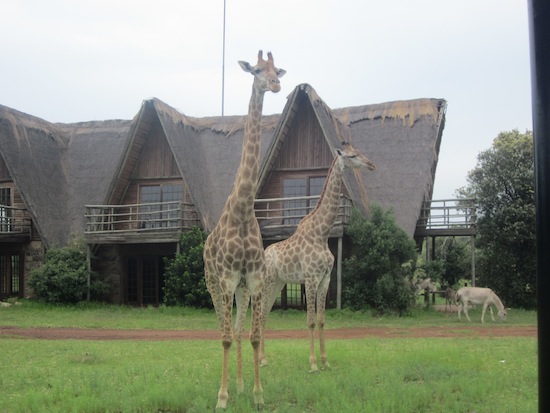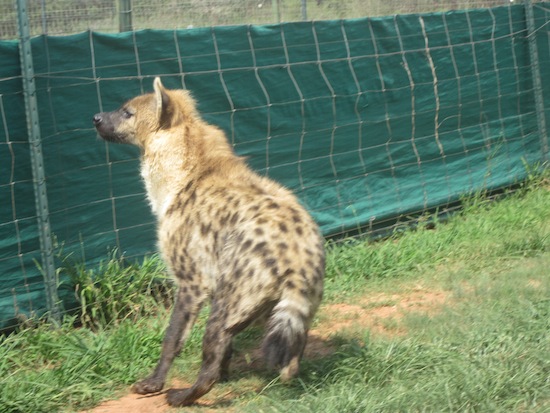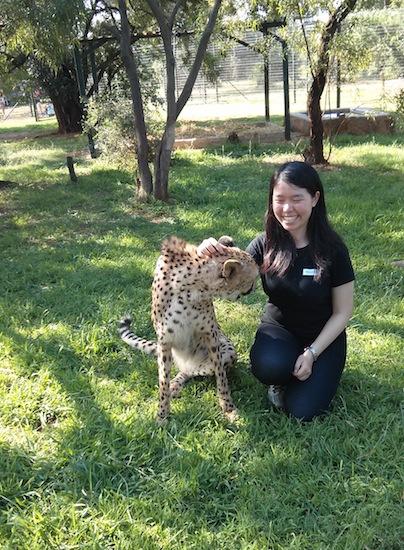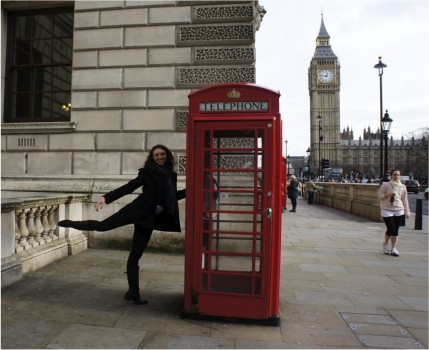What makes an adult human or animal “cute?” According to scholars working in developmental biology and psychology, the answer relates to juvenile traits, such as small jaws, short limbs, a large head, seemingly huge eyes, etc. This is called “neoteny;” and among humans, neotenous characteristics are thought to stimulate care-giving behaviors.
But Alumni Memorial Scholar Linh Bui ’14 wondered whether neoteny also plays a role in human-animal relationships. As a Colgate psychology major and general animal lover, she hoped to investigate whether caregivers treat wild animals living in captivity differently–based on their relative cuteness. Linh developed an AMS grant proposal that took her to a lion park in Johannesburg, South Africa during January of 2014. “Those two weeks were a highlight of my Colgate experience,” she wrote. In what follows, Linh reflects on her AMS grant and her experience as a volunteer at the park.

Girraffes around volunteers’ dorm
The lion park is an animal lover’s dream come true with all types of wild animals walking around. I woke up to zebras grazing in front of my door; I had to guard my lunch against giraffes; and of course, at night, I was careful not to run into hippos! The lion park offered many activities, such as a game drive, a lion walk, an elephant walk, etc. It was definitely not an “easy vacation” though. My fellow volunteers and I worked from 7 a.m. until 5 p.m., and our daily tasks included weeding the grazing hills, picking up poop and bones from the predator camps, and digging a swimming pool for the elephants.

Roxy the hyena runs to visit when her name is called.
I used my free time during lunch and after dinner to conduct informal interviews and observations for my AMS project. I discovered the volunteers’ interactions with animals were, indeed, governed by “cuteness”–just not in the way I expected. For example, most people would say hyenas are ugly and scary, but many volunteers loved Roxy, the hyena at the park, for how dog-like she was. She would run to visit whenever we called her name. Another animal, a fully-grown cheetah named Oliver, would be called “scary” instead of “cute,” but volunteers simply adored the fact that he purred when petted. Some volunteers even liked the ostriches best, because ostriches followed them around. Cuteness can be defined behaviorally, not just physically.

Oliver the purring cheetah
Aside from enabling me to carry out my research, my two weeks at the lion park also taught me to appreciate physical labor. To be honest, I had never done physical labor in my life, so it was quite a shock. Before the trip, I did expect to clean up after the animals, but nothing could have prepared me for the task of shoveling elephant poop! The hard work did pay off though, and I learned how to use agricultural tools properly. Seeing the final results of my work made me very happy. A highlight of my trip was watching the elephants playing happily in the swimming pool we made for them: they splashed water and mud on everybody, but none of us cared.

Picture with the lion siblings
Despite the hard work, I learned many things about neoteny, had a lot of fun, and even got to pet lions. I definitely recommend that all AMS student take advantage of the AMS Grant experience. Why would you hesitate to travel abroad and pursue your interests?



